Creative DIY Garden Ideas: Ceramic Planters

Welcome to the world of creative DIY garden ideas! Here, we're going to explore the wonderful realm of ceramic planters and discover how they can bring beauty and charm to your outdoor space.
Whether you're an experienced gardener or just starting, this guide will inspire you to create your very own outdoor planters that perfectly blend with nature.
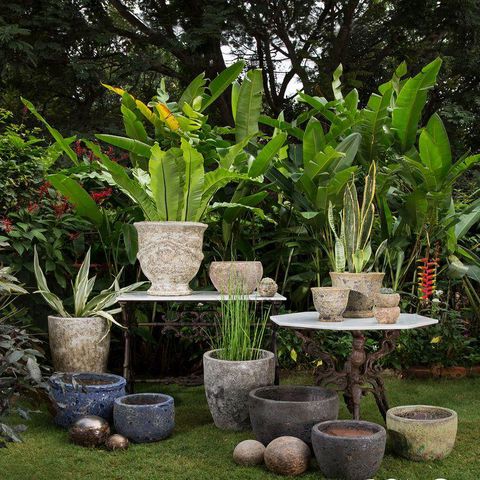
Decoration with Ceramic Planters: Benefits of Them
When it comes to your garden decor, ceramic planters offer a lot of benefits that can make your outdoor space look even more beautiful. These planters are versatile and come with many advantages that allow you to have creative gardening projects.
Firstly, you can find ceramic planters in different sizes, shapes, and colors, so you can easily find one that matches your DIY garden ideas. They are also strong and can handle different weather conditions, making them perfect for year-round use.
Ceramic planters have a special quality that helps regulate the moisture in the soil, keeping your plants healthy and preventing overwatering. They also provide good insulation for plant roots, protecting them from extreme temperatures.
DIY ceramic planters are also budget-friendly since you can repurpose materials or use affordable supplies to create them. Plus, by using DIY ceramic planters, you not only make your garden more beautiful but also enjoy the fun and rewarding experience of creating something yourself.
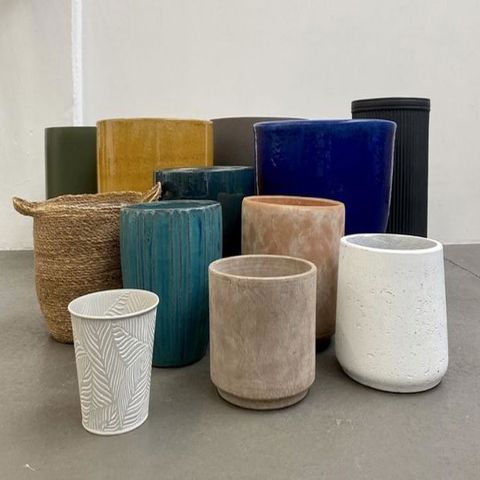
Choosing the Right Ceramic Planter
When selecting a pot, there is no "incorrect" choice, but the right choice depends on which pot suits your plant the best. Ceramic pots, similar to terracotta pots, are made of porous clay, but ceramic pots often have a glazed surface. The glaze helps slow down soil drying compared to terracotta pots.
Unglazed ceramic pots promote air and water movement, which encourages root growth and results in a happier plant. However, the clay in these pots also absorbs moisture from the soil, which is beneficial for those who tend to overwater or have plants that prefer drier soil conditions.
On the other hand, glazed ceramic pots do not retain as much moisture as plastic pots and limit air circulation, but they do not dry out as quickly as terracotta pots. Just like plastic pots, ceramic flower pots are available in various colors and sizes. Whether you are seeking gifts for animal lovers or looking for DIY garden ideas inspired by the cosmos, you can find ceramic pots to suit your needs.
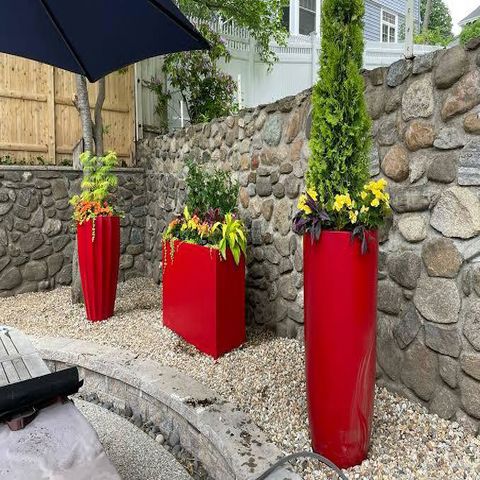
Consider the Size and Weight of the Planter
Size is a crucial factor to consider when selecting a pot for your indoor plant. The size of the pot plays a significant role in determining the amount of soil accessible to the plant, which directly influences its growth and overall well-being.
If the pot is too small, it can hinder root expansion and restrict the plant's ability to absorb nutrients effectively. Conversely, an excessively large pot can retain excessive moisture in the soil, potentially leading to root rot and other related problems.
Additionally, the weight of the pot should not be overlooked. Larger and heavier pots can present challenges when it comes to mobility, requiring additional support such as a plant stand or a stable surface to hold them securely.
If you plan to move your plant frequently or need to move it indoors and outdoors, a lighter pot may be a better choice.

Choose a Design That Matches Your Garden
Pots come in many shapes and sizes, such as ceramic, terracotta, aluminum, fiberglass, stone, concrete, and plastic. Plants can be planted into any number of containers – you are only limited by your imagination and the space you must work with.
Before buying pots, consider the architecture of your home and the style of the garden. For a contemporary look, you could choose a planter with a simple geometric shape in Corten steel, fiberglass, or concrete.
Try terracotta pots with clipped mounds of Buxus sempervirens or a standard bay tree for a classic, formal style. Repurposing containers such as wooden wine barrels or vintage watering cans will also add a quirky touch. Just fill them with colorful annuals or fragrant herbs.
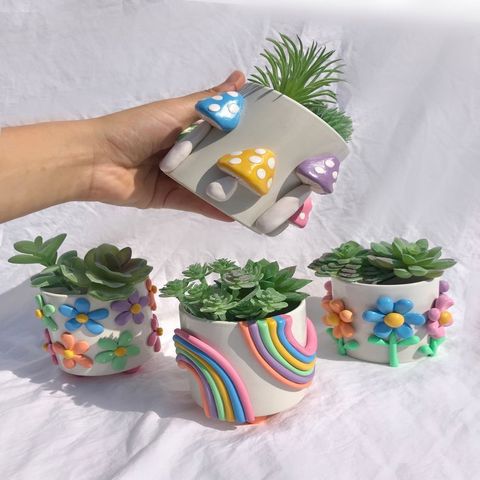
DIY Ceramic Planter Ideas
Are you looking for DIY garden ideas? Then ceramic planters got you covered! Ceramic planters look so unique and yet are easy to make. You can start with a terracotta pot, add some molded clay and a few coats of paint, and end up with the best garden decor.
Ceramic planters as one of the best DIY garden ideas are also going to look fabulous on your Thanksgiving or any event table!
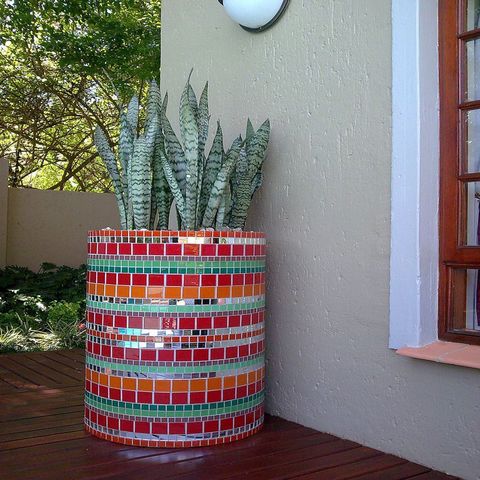
Mosaic Ceramic Planters
While making the flower pot, first you should gather damaged plates and cups, in light and pleasant colors. Imagine a calm pot on one side and a dramatic one on the other. This is what will come out and you will be so pleased with the result!
Would you like to offer something special to a loved one for their special day? Or buy/make a flower pot for yourself? Or organize an afternoon with family/friends to make your flower pot? You can buy mosaic ceramic planters as finished products or as a kit including everything you need to create your DIY garden ideas. You can personalize your flower pot by choosing your colors.
Creating your mosaic planters allows you to infuse your personality and creativity into your outdoor space. These DIY garden ideas become eye-catching focal points, showcasing your creativity and making your garden design truly unique.

Hand-Painted Ceramic Planters
Imagine you come across some adorable outdoor cushions and decide to give your deck or patio a fresh look this summer. However, now you realize that your ceramic planters don't match the new cushions.
Buying new ones that match might not be feasible within your budget. But don't worry! We have a super easy solution for you—a makeover for your ceramic planters using spray paint.
Instead of leaving your ceramic pots idle on the shelves or considering throwing them away because they are old, you can repurpose them with exciting DIY garden ideas.
The question arises: Can you paint ceramic pots? Well, the answer is yes, and there are various ways to do it. One of the most common methods involves hand-painting or using spray paint.
Before painting, it's important to clean and sand the pots properly. There are several types of paint suitable for ceramic pots, with acrylic, epoxy, and latex paints being the most commonly used. These paints are versatile and can be applied to various ceramic products such as mugs, pots, vases, tiles, and more.
However, not all paints are equally effective and long-lasting. It's crucial to be attentive and selective when choosing paints for your ceramic planters. If you prefer painting by hand, liquid paints are convenient. For a glossy and durable finish, epoxy paints are the optimal choice. On the other hand, if affordability is a priority, acrylic or latex paints are great options that also yield excellent results on ceramic wares. Acrylic paints are particularly suitable for small ceramic planters.
Another popular choice for painting ceramics is spray paint. It offers a straightforward application process and provides a long-lasting finish. Moreover, spray paints are affordable and readily available in the market.
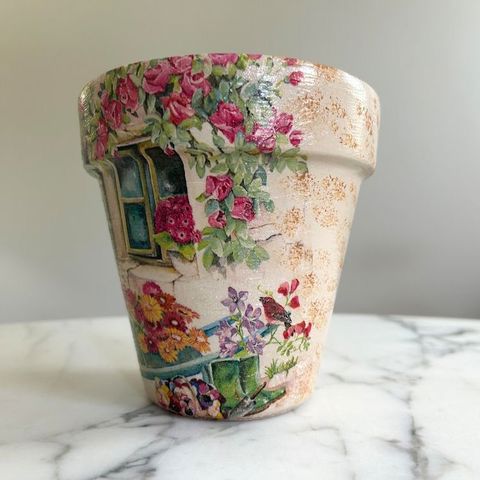
Decoupage Ceramic Planters
This easy craft adds beauty to your DIY garden ideas and also makes a great gift.
Decoupage is a technique that involves layering decorative paper or fabric onto a surface using adhesive, resulting in a beautifully textured and personalized finish. By applying decoupage to ceramic planters, you can add a touch of charm and elegance to your garden while showcasing your unique style.
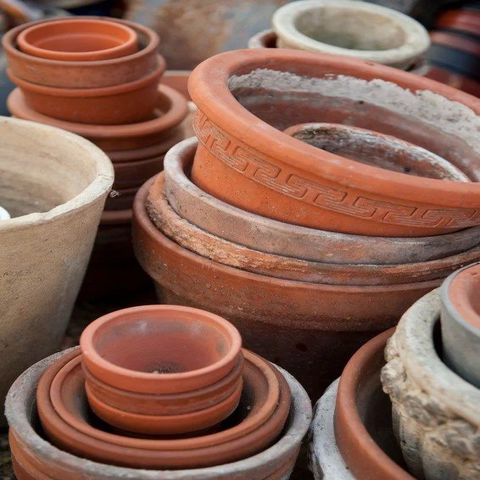
Care and Maintenance of Ceramic Planters
To keep your ceramic planters looking nice and your plants happy, you need to take care of them.
First, make sure to clean them regularly by using a soft cloth or sponge with some mild soap and water. Don't use anything rough that might scratch the ceramic.
It's also important to have good drainage, which means having holes at the bottom of the planters so water can drain out. If there aren't any holes, you can put some small rocks or pebbles in the bottom to help with drainage.
When you water your plants, be careful not to give them too much water. Let any extra water drain out of the planter so the roots don't get too wet.
During cold weather, it's a good idea to bring your ceramic planters inside or put them in a safe place where they won't freeze and crack. And remember, be gentle when moving your planters to avoid breaking them. If you notice any cracks or chips, you can use a special glue made for ceramics to fix them.
You can reach our previous article from https://www.artmasterclass.com.au/blogs/news/unleash-your-inner-artist-the-best-summer-activities





